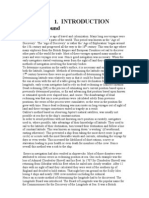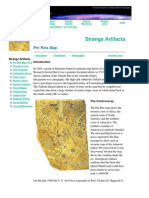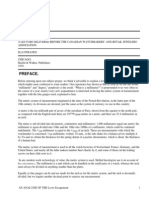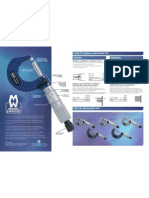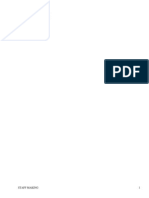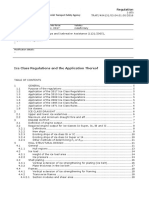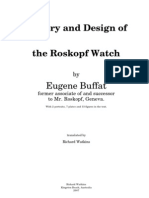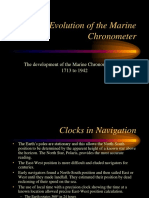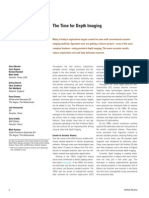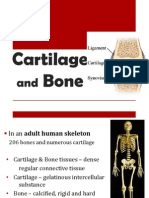John Harrison Longitude
John Harrison Longitude
Uploaded by
shearstressCopyright:
Available Formats
John Harrison Longitude
John Harrison Longitude
Uploaded by
shearstressCopyright
Available Formats
Share this document
Did you find this document useful?
Is this content inappropriate?
Copyright:
Available Formats
John Harrison Longitude
John Harrison Longitude
Uploaded by
shearstressCopyright:
Available Formats
JOHN HARRISON AND THE LONGITUDE PROBLEM John Harrison is known for receiving a UK Parliament award for his
chronometer. The importance of his invention was that it was suitable for use at sea and thus helped navigators of the time to precisely determine Longitude. The H5, Harrisons fifth attempt at a marine timekeeper, was precise to a tenth of a second per day, which is very impressive even by todays standards. But lets take things from the start...ish... During the seventeenth and eighteenth centuries, development of navigation instruments was encouraged, since seafaring was used more and more for trading and was the only means of exploring. Navigation by definition is the science of ascertaining ones position, and subsequently plotting and following a course. Latitude - how many degrees North or South someone is positioned from the equator - could be determined easily within the accuracy of a degree, by means of measuring the altitude of celestial bodies using a sextant, an astrolabe or other instruments. Longitude on the other hand was not as easy to be determined. The theory was there though: The earth needs twenty-four hours to perform one complete revolution around its axis. Therefore it rotates fifteen degrees per hour. So for example, if I know that it is 12:00 (noon) at a given location, but where Im at is still 11:00, then Im fifteen degrees away from the former location. Sailors could estimate the current time by observing the suns position but had great difficulty knowing the time of a reference location in this case the reference location was Greenwich.
King Charles II founded the Greenwich Royal Observatory (1675) for this exact reason. Tables of the position of the moon relative to the stars where compiled, in order to help sailors estimate the time at Greenwich, but the method was inaccurate. So in 1714, the Parliament approved the Governments request for awarding 20,000 pounds to the person who would find a way to estimate Longitude within an accuracy of half a degree. Even a Board of Longitude was formed, in order to review and evaluate the contestants and their inventions. John Harrison 21 at the time was a self-taught clock maker and repairer. He would even improve designs and mechanisms of clocks taken to him for repair. By 1728, he had enough drawings and full scale models of parts of his proposed solution, so he headed to London to seek financial assistance. He was advised to see George Graham, who was at the time the master of the Clockmakers Company. Graham was impressed enough to loan Harrison money from his personal fund to help him develop his idea. Sometime between 1730 and 1735, Harrison finished his first marine timekeeper.
Harrison's H1
The H1 was a heavy, weird looking clock which had to be wound every day, as opposed to the wooden clocks of the day that had an eight day power reserve. It did not use a pendulum, but a balance mechanism which would compensate any change in motion, therefore minimizing the effects of the direction of gravity. It was accurate to three seconds a day. In 1736, H1 and its maker travelled by sea to Lisbon and back so the timekeeper would be tested under the circumstances it was designed for. The H1 was good enough to correct the Longitude readings on the way back but Harrison requested from the board of Longitude more money in order to proceed in creating a second marine timekeeper. After working on the second incarnation (H2) of the timekeeper for about 4 years, he discovered that the design of the bar balances used to compensate a ships rocking motion was flawed. He then proceeded with his third attempt. It took 19 years for H3 to materialize. It failed to reach the accuracy demanded, and even though it was smaller and lighter than its predecessors, it was still a cumbersome clock, and impractical to adjust. It was important for two of its parts though: the bimetallic strip, and roller bearings.
They were designed to compensate for changes in temperature and to minimize friction on the movement respectively, and they were innovations that found their way in all sorts of machinery and mechanisms thereafter. After finishing the H3, Harrison was convinced that a large clock would not be suitable for the purpose.
H2 and H3
H4
Enter the H4. It was a watch instead of a clock, albeit a big one since it was about 13cm in diameter. William, Johns son, travelled with this watch to Jamaica aboard the ship Deptford, and after the two months it took them to get there, the H4 was only an impressive 5.1 seconds slow. A second trip followed with an error of 39.2 seconds over 47 days. That was three times better than the accuracy requested by the board. Despite this accuracy, the board insisted that the watch was a fluke and that copies of it should be made and tested. They would award Harrison with
half the prize money when he submitted his timekeepers along with all his secrets, and the rest when accurate copies of H4 would be made. Needless to say that was not what Harrison wanted, but the board must have been very determined since in 1765 all four timekeepers were submitted. Larcum Kendall was also appointed to copy H4. Now the board wanted Harrison to make two more copies of H4 in order to award him the second half of the prize money. John and son started working on a fifth timekeeper (H5) while Kendall worked on his copy of the H4, the K1. The board though insisted that both copies should be made by the Harrisons, and would not regard H5 and K1 as the two copies of H4. Even after H5 met the approval of King George III, the Harrisons had to petition Parliament to receive an amount of 8750 in 1773. The significance of course is the recognition that John Harrison solved the Longitude problem.
H5
It is important to say that Kendalls K1 was used and enthusiastically approved by Captain James Cook. It confirmed that a marine timekeeper was the best and most accurate way of determining Longitude. 1, 2, 3 & 4 are now kept at the National Maritime Museum (Greenwich, London) and the H5 is at the Clockmakers Museum at Guildhall, London.
You might also like
- JHC BookDocument325 pagesJHC Bookstuart5946100% (10)
- Longitude: The True Story of a Lone Genius Who Solved the Greatest Scientific Problem of His TimeFrom EverandLongitude: The True Story of a Lone Genius Who Solved the Greatest Scientific Problem of His TimeRating: 4 out of 5 stars4/5 (145)
- Piri Reis Map HistoryDocument5 pagesPiri Reis Map HistoryI'm 27 year old, and a Graphic Designer by profession.100% (1)
- Biology Unit Plan Carriesun Sbi3uDocument18 pagesBiology Unit Plan Carriesun Sbi3uapi-285245808100% (1)
- Marine ChronometerDocument19 pagesMarine ChronometerSarah Dillard100% (1)
- MSDS - Spectrus Bd1551eDocument8 pagesMSDS - Spectrus Bd1551eLee ColeNo ratings yet
- Strange Artifacts: Piri Reis MapDocument6 pagesStrange Artifacts: Piri Reis Mapjazzfunks100% (1)
- Chapter 1 Cornell NotesDocument3 pagesChapter 1 Cornell NotesgNo ratings yet
- Kent Hovind - Seminar Transcriptions 1999 On CreationismDocument117 pagesKent Hovind - Seminar Transcriptions 1999 On CreationismMagnentius100% (1)
- Install VFD On Grizzly G0602 10x22 LatheDocument8 pagesInstall VFD On Grizzly G0602 10x22 Lathec_a_messmerNo ratings yet
- An Analysis of The Lever Escapement by Playtner, H. R.Document46 pagesAn Analysis of The Lever Escapement by Playtner, H. R.Gutenberg.orgNo ratings yet
- Gruen Watchmaking LessonsDocument41 pagesGruen Watchmaking LessonsSidney SantosNo ratings yet
- Beet Sugar Bioethanol FermentationDocument12 pagesBeet Sugar Bioethanol FermentationDavidNo ratings yet
- Reading A MicrometerDocument1 pageReading A Micrometermatrix93No ratings yet
- A Treatise On Staff Making and PivotingContaining Complete Directions For Making and Fitting NewStaffs From The Raw Material by Hall, Eugene EdwardDocument29 pagesA Treatise On Staff Making and PivotingContaining Complete Directions For Making and Fitting NewStaffs From The Raw Material by Hall, Eugene EdwardGutenberg.org100% (1)
- PIR CatalogueDocument12 pagesPIR CatalogueUmen AryanNo ratings yet
- Gauge BlockDocument6 pagesGauge BlockrexkingdomNo ratings yet
- Solar Position AlgorithmDocument56 pagesSolar Position AlgorithmChristopher MendezNo ratings yet
- The Watch RepairerDocument2 pagesThe Watch RepairersurintanNo ratings yet
- TRAFI 494 131 03 04 01 00 2016 EN Jaaluokkamaarays 2017Document65 pagesTRAFI 494 131 03 04 01 00 2016 EN Jaaluokkamaarays 2017Maxim100% (1)
- Emission Characteristics of Hydrogen Oxygen FlamesDocument8 pagesEmission Characteristics of Hydrogen Oxygen FlamesRaghavNo ratings yet
- Area Rule Richard Whitcomb PDFDocument16 pagesArea Rule Richard Whitcomb PDFMuthyala Akhil0% (1)
- RoskopfDocument51 pagesRoskopfIpate EugenNo ratings yet
- Journal of Fluid Mechanics Volume 7 Issue 04 1960 (Doi 10.1017/S0022112060000281) Shaw, R. - The Influence of Hole Dimensions On Static Pressure MeasurementsDocument15 pagesJournal of Fluid Mechanics Volume 7 Issue 04 1960 (Doi 10.1017/S0022112060000281) Shaw, R. - The Influence of Hole Dimensions On Static Pressure MeasurementsresonancebansalNo ratings yet
- Datasheet Sensor PMS5003Document15 pagesDatasheet Sensor PMS5003Ivan PalaciosNo ratings yet
- Horologium, Solo Naturae Motu, Atque Ingenio, Dimetiens, Et Numerans Momenta Temporis, Constantissime AequaliaDocument12 pagesHorologium, Solo Naturae Motu, Atque Ingenio, Dimetiens, Et Numerans Momenta Temporis, Constantissime AequaliaEugeniu SemenciucNo ratings yet
- Black Greenwich First MeridianDocument9 pagesBlack Greenwich First MeridianLeca RaduNo ratings yet
- Harrisons Clocks Longitude ProblemDocument1 pageHarrisons Clocks Longitude ProblemJon JensenNo ratings yet
- Timekeeper - Invention of Marine ChronometerDocument4 pagesTimekeeper - Invention of Marine Chronometersecretguy5464No ratings yet
- (PE) (Cox) John HarrisonDocument4 pages(PE) (Cox) John Harrisonjcb1961No ratings yet
- Evolution Marine ChronometerDocument51 pagesEvolution Marine Chronometeranon_835518017100% (2)
- IELTS Reading Recent Actual Test 02 With AnswerDocument9 pagesIELTS Reading Recent Actual Test 02 With AnswerNhung TâyNo ratings yet
- Online StopwatchDocument3 pagesOnline StopwatchKaseyqveyzlxLebNo ratings yet
- John_HarrisonDocument16 pagesJohn_Harrisonruth.katherina.lopezNo ratings yet
- 97 Passage 1 - Timekeeper Invention of Marine Chronometer Q1-14Document5 pages97 Passage 1 - Timekeeper Invention of Marine Chronometer Q1-14Thục Linh TrươngNo ratings yet
- TimekeeperDocument4 pagesTimekeeperk61.2211510098No ratings yet
- TimekeeperDocument4 pagesTimekeeperTrần Văn Chế ThanhNo ratings yet
- Lost at Sea: The Search For Longitude: Panth DesaiDocument3 pagesLost at Sea: The Search For Longitude: Panth DesaiP SCRIBD D scribdNo ratings yet
- Extra Reading Practice - Common Task TypesDocument7 pagesExtra Reading Practice - Common Task Typeslienthuy3001No ratings yet
- IAT6 - Reading Test 3Document10 pagesIAT6 - Reading Test 3Minh An NguyễnNo ratings yet
- Reading Passage 1Document12 pagesReading Passage 1Awais AlamNo ratings yet
- Ielts Reading Vol 6 Test 3Document6 pagesIelts Reading Vol 6 Test 3minnieheeheeNo ratings yet
- IELTS Reading TestDocument17 pagesIELTS Reading TestAngus P. RoblesNo ratings yet
- Origins of The Halifax Dockyard Observatory 1Document34 pagesOrigins of The Halifax Dockyard Observatory 1doug heffernen100% (1)
- Sejarah Waktu, GMT, Navigasi PelayaranDocument2 pagesSejarah Waktu, GMT, Navigasi PelayaranUmmu HaniNo ratings yet
- Mocktest Reading 3004Document12 pagesMocktest Reading 3004Nguyễn Trịnh Thảo TrinhNo ratings yet
- Measuring Tools Machinery's Reference Series Number 21From EverandMeasuring Tools Machinery's Reference Series Number 21Rating: 4 out of 5 stars4/5 (1)
- Hamilton Marine ChronometerDocument15 pagesHamilton Marine ChronometerDavid100% (1)
- Readingpracticetest3 v9 2559205 PDFDocument13 pagesReadingpracticetest3 v9 2559205 PDFHendry WijayantiNo ratings yet
- A Brief Account of The ChronometerDocument37 pagesA Brief Account of The ChronometerPeter RendleNo ratings yet
- Readingpracticetest3 v9 2559205Document15 pagesReadingpracticetest3 v9 2559205Hi ChemNo ratings yet
- Reading Practice Test 3 - Vol 6Document15 pagesReading Practice Test 3 - Vol 6Thu but bi100% (1)
- 19-01-SobelDocument3 pages19-01-SobelKunjavaaNo ratings yet
- Science GeographyDocument133 pagesScience Geographysampcant212No ratings yet
- Fingerprints of the Gods: The Evidence of Earth's Lost CivilizationFrom EverandFingerprints of the Gods: The Evidence of Earth's Lost CivilizationNo ratings yet
- Piri Reis Map Proof of Ancient Advanced CivilisDocument21 pagesPiri Reis Map Proof of Ancient Advanced CivilisAntonio AzevedoNo ratings yet
- John Bird 1709-1776 Mathematical Instrument Maker in The Strand by C. D. HellmanDocument29 pagesJohn Bird 1709-1776 Mathematical Instrument Maker in The Strand by C. D. HellmanZyberstormNo ratings yet
- Inventions HENRY MAUDSLAY (1771-1831)Document12 pagesInventions HENRY MAUDSLAY (1771-1831)Adriatik MetaNo ratings yet
- Cloaca: Alendar LepsydraDocument26 pagesCloaca: Alendar LepsydraTheodor EikeNo ratings yet
- Subiectul I Complete The Sentences With The Negative Form of The Adjectives in The BoxDocument3 pagesSubiectul I Complete The Sentences With The Negative Form of The Adjectives in The BoxMihaela RaduNo ratings yet
- SBBMCH 2002Document169 pagesSBBMCH 2002rousesNo ratings yet
- China University of Petroleum GEO Science Professoors CntactsDocument27 pagesChina University of Petroleum GEO Science Professoors CntactsTurab ZaidiNo ratings yet
- 2013 Fractured Weathered Basement Reservoirs Best Practices For Exploration Production - Examples From USA, Venezuela, and Brazil - Tako KoningDocument29 pages2013 Fractured Weathered Basement Reservoirs Best Practices For Exploration Production - Examples From USA, Venezuela, and Brazil - Tako KoningHafizhan Abidin SetyowiyotoNo ratings yet
- Laramide Orogeny: I 1,000 Miles IDocument18 pagesLaramide Orogeny: I 1,000 Miles IDavid Karel AlfonsNo ratings yet
- Reading - Galaxy CollisionDocument4 pagesReading - Galaxy CollisionKian Tuan-AnhNo ratings yet
- Geotechnical Properties of Norwegian Marine Clays-BjerrumDocument21 pagesGeotechnical Properties of Norwegian Marine Clays-BjerrumAnonymous GnfGTwNo ratings yet
- Albertin - The Time For Depth ImagingDocument14 pagesAlbertin - The Time For Depth ImagingkurtpeekNo ratings yet
- List of Important University FunctionariesDocument17 pagesList of Important University FunctionariesnkfavasNo ratings yet
- NSHF November 2012Document128 pagesNSHF November 2012Nancy BainNo ratings yet
- The Biology Model Examination For Grade 12 in 2009/2017Document16 pagesThe Biology Model Examination For Grade 12 in 2009/2017koket negash100% (2)
- Venus Morning StarDocument20 pagesVenus Morning StarceudekarnakNo ratings yet
- Varaha Mihira's Sarvato Bhadra ChakraDocument54 pagesVaraha Mihira's Sarvato Bhadra Chakraclivecussler17No ratings yet
- Acid Bearing Rock Policy - Draft 4-11-14Document52 pagesAcid Bearing Rock Policy - Draft 4-11-14rshaghayanNo ratings yet
- Cartilage and BoneDocument54 pagesCartilage and BoneAGolosinoNo ratings yet
- Mars Inharmonious SaturnDocument2 pagesMars Inharmonious SaturnPhalgun BalaajiNo ratings yet
- Interpreting The Moon NodesDocument3 pagesInterpreting The Moon NodesOtilia Mazilu100% (1)
- Registro de Mamíferos Silvestres en La Ruta 32 (Artavia Et Al. 2015)Document10 pagesRegistro de Mamíferos Silvestres en La Ruta 32 (Artavia Et Al. 2015)Adolfo ArtaviaNo ratings yet
- By Joni Patry, Usa: Passing of Vedic Astrologer David LagroneDocument9 pagesBy Joni Patry, Usa: Passing of Vedic Astrologer David LagronePrasan NandaNo ratings yet
- Laboratory Name: Accreditation Standard Certificate Number Page No Validity Last Amended OnDocument9 pagesLaboratory Name: Accreditation Standard Certificate Number Page No Validity Last Amended OnTRUCAL NABLNo ratings yet
- Physics Form 2 Eval 1Document3 pagesPhysics Form 2 Eval 1Nkengfac LoiekNo ratings yet
- Soybean Adaptation To Low Light Intensity: Leaf Characters For The Light Capture EfficiencyDocument8 pagesSoybean Adaptation To Low Light Intensity: Leaf Characters For The Light Capture EfficiencyRathna rateNo ratings yet
- Metamorphic Rocks - An Introduction To MetamorphismDocument32 pagesMetamorphic Rocks - An Introduction To MetamorphismMd. Asif HasanNo ratings yet
- Liceo de Cagayan University: College of Medical Laboratory ScienceDocument6 pagesLiceo de Cagayan University: College of Medical Laboratory Scienceserainie maiNo ratings yet
- Evolution Islam - A PerspectiveDocument38 pagesEvolution Islam - A Perspectiveapi-251206250No ratings yet
- Charles Darwin and The Theory of Evolution: Reading ToeflDocument1 pageCharles Darwin and The Theory of Evolution: Reading Toeflyencar romeroNo ratings yet
- Stereo Nets How To PlotDocument12 pagesStereo Nets How To Plotoli659No ratings yet




